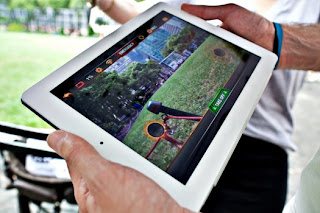Parrot's second-gen recreational drone packs new hardware that makes for a smoother, more controlled piloting experience
After enthusiastically covering the debut of Parrot at the Consumer Electronics Show back in 2010, PopSci went on to honor the camera-equipped, remotely-piloted quadrotor with a Best of What’s New distinction. And so with that in mind I unboxed the newest iteration--properly named AR.Drone 2.0--prepared for some degree of disappointment. Second-generation products, as often as not, tend to correct flaws in the first generation and marginally refresh or update certain features (now with HD camera!) without drastically improving or reinventing the core product or experience. I approached Parrot’s newest drone accordingly.
This was a misjudgment. That’s not to say the AR.Drone 2.0 is a completely re-imagined concept--the aerial vehicle itself is essentially the same--but the latest version has taken several significant technological strides forward, packing a stronger suite of sensor technology and improved hardware that make piloting the quadcopter an order of magnitude more intuitive (and a whole lot of fun).
WHAT’S NEW
Outwardly the AR.Drone 2.0 is still the same quadcopter, bearing a few minor aesthetic changes. The significant upgrades are all interior. A new pressure sensor helps keep the AR.Drone 2.0 vertically stable at altitudes as high as 164 feet (the first-gen drone’s ultrasound sensors maintained stability only up to about 20 feet). A 3-axis magnetometer joins the 3-axis gyro and 3-axis accelerometer that were already there, making it significantly easier to pilot (more on that later). Version 2.0 also received its first built-in, automated maneuvering function--double-tap the screen of your control device (like its predecessor, the AR.Drone 2.0 is controlled via a smartphone or tablet app) and the aircraft executes a midair flip.
Outwardly the AR.Drone 2.0 is still the same quadcopter, bearing a few minor aesthetic changes. The significant upgrades are all interior. A new pressure sensor helps keep the AR.Drone 2.0 vertically stable at altitudes as high as 164 feet (the first-gen drone’s ultrasound sensors maintained stability only up to about 20 feet). A 3-axis magnetometer joins the 3-axis gyro and 3-axis accelerometer that were already there, making it significantly easier to pilot (more on that later). Version 2.0 also received its first built-in, automated maneuvering function--double-tap the screen of your control device (like its predecessor, the AR.Drone 2.0 is controlled via a smartphone or tablet app) and the aircraft executes a midair flip.
And, yes, the drone’s front camera can now shoot in 720p HD at 30 frames per second, which it beams right to the screen of whatever smartphone or tablet you are using to pilot, giving you a drone’s-eye view. But it now also records that footage, dumping video and still images to an on-board USB drive or to the pilot’s control device. Privacy advocates might have something to say about that, but as a feature it lends the Parrot AR.Drone 2.0 an added aspect of utility beyond simple recreation.Piloting the AR.Drone via iPad: Dan Bracaglia
WHAT’S GOOD
Enhanced Control: As noted above, Parrot’s drones are controlled via a smartphone or tablet app (we used both an iPad and an iPhone for this review, with similar good results for each) through an interface that is in one sense remarkably intuitive and in another mildly frustrating. The drone mimics the tilt of your device, so to fly it forward you tilt your smartphone forward, and to fly right or left or backward or some combination of those, you tilt your smartphone accordingly. That’s the intuitive part. But when you rotate the drone (which is done via a touchscreen joypad within the app) to the point where you and the drone are no longer facing the same direction--let’s say the drone is facing 90 degrees to your right--all intuition dissolves immediately. Now, if you tilt your phone forward the drone travels to your right. If you tilt your phone to the right, the drone comes back toward you.
Enhanced Control: As noted above, Parrot’s drones are controlled via a smartphone or tablet app (we used both an iPad and an iPhone for this review, with similar good results for each) through an interface that is in one sense remarkably intuitive and in another mildly frustrating. The drone mimics the tilt of your device, so to fly it forward you tilt your smartphone forward, and to fly right or left or backward or some combination of those, you tilt your smartphone accordingly. That’s the intuitive part. But when you rotate the drone (which is done via a touchscreen joypad within the app) to the point where you and the drone are no longer facing the same direction--let’s say the drone is facing 90 degrees to your right--all intuition dissolves immediately. Now, if you tilt your phone forward the drone travels to your right. If you tilt your phone to the right, the drone comes back toward you.
Parrot remedied the need for the pilot to be constantly compensating for the direction the drone is facing via a 3-axis magnetometer that tells the drone precisely how it is oriented respective to the control device. With the “Absolute Control” option switched on in the app’s settings, the drone flies with respect to the way the device is facing, regardless of which way the drone is facing (if you tilt your phone to the left, the drone always flies to your left regardless of whether that’s the drone’s left or not). This drastically simplifies piloting. Where version 1.0 took a period of getting used to, a user can get comfortable piloting version 2.0 virtually right out of the box.


No comments:
Post a Comment